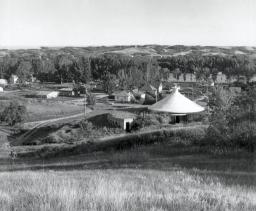
Wild rice (Zinzania palustris) is a native North American aquatic cereal grain that historically grew in Canada in lakes and riverbeds, in southeast Manitoba and west and north of the Great Lakes. This nutritious grain was utilized for centuries by Aboriginal people; it was considered as a sacred grain in their diet. Early French explorers referred to the grain as riz sauvage (wild rice) and adopted the nutritious grain as a food source in their travels. In the 1930s, wild rice was first introduced into northern Saskatchewan as a food supplement for fur-bearing animals and waterfowl. In the 1980s, development agencies in pursuit of a northern agricultural economic strategy supported the rapid expansion of commercial production for human consumption. Eventually an area encompassing the western headwaters of the Churchill River basin, across the Precambrian Shield and to the Cumberland Delta in the east was growing wild rice.
Wild rice is an annual plant that grows from seed each spring in the shallow waters (maximum depth of 1.75 m) of slow-moving rivers and lake bays. In order to preserve the sensitive aquatic environment, provincial law forbids the usage of commercial fertilizers, herbicides or insecticides to enhance production. This naturally grown product qualifies for organic certification, and is often designated as such to gain market access and recognition. Harvesting is done by airboats that skim on the water at a speed of 15–20 km per hour with specially designed collection trays to gather the ripened kernels of grain. Since seeds do not ripen uniformly, this harvesting process must be repeated up to four times per site. The grain is very prone to shattering, and the fallen grain becomes the seed source for ensuing crops. The harvested wild rice is matured during a curing process of ten to fourteen days, during which time the kernels harden and darken to their characteristic dark brown and black coloration. After curing, the wild rice is parched at high temperatures to gelatinize the starch and reduce the moisture content to less than 10%. Dehulling and grading as to kernel size are the final stages in processing. No additives, flavourings or colourants are used in the processing of this natural food product.
Wild rice, a nutritious grain high in protein and fibre, is an excellent source of B vitamins and is low in fat content. It is a very versatile food item which can be consumed in soups, salads, main entrees and desserts. The annual production of wild rice can be quite variable; however, Saskatchewan is the major producer of wild rice in Canada with an annual production of approximately 0.9 million kg, as compared with a total Canadian production of 1.36 million kg. In the United States, mainly in Minnesota and California, paddy wild rice is grown under commercial farming conditions where approximately 9 million kg are grown each year; in Minnesota there is a small-lake wild rice harvest of approximately 0.227 million kg each year. Saskatchewan’s naturally grown lake wild rice is marketed across North America and Europe, and is recognized as a premium product owing to its large kernel size, dark coloration, and nutty flavour.
John Hemstad